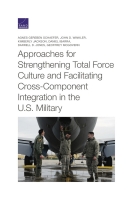by Agnes Gereben Schaefer
 While all U.S. military services have strived to achieve greater total force integration and a stronger total force culture across their active and reserve components, significant impediments limit the achievement of these objectives. Thus, the issue continues to capture the attention of policymakers who seek ways to overcome these impediments and facilitate greater integration.
While all U.S. military services have strived to achieve greater total force integration and a stronger total force culture across their active and reserve components, significant impediments limit the achievement of these objectives. Thus, the issue continues to capture the attention of policymakers who seek ways to overcome these impediments and facilitate greater integration.
This priority has been addressed most recently by national commissions addressing the future of both the Army and the Air Force. While each of these sets of proposals provides ideas for enhancing integration and providing a greater total force culture, the proposals are neither complete nor fully reflective of all potentially relevant policies and practices. Further, the policy prescriptions are service specific and do not reflect broader insights that cut across services. Last, none of these efforts clearly define the desired purpose and end state for integration against which integration initiatives can be evaluated. For these reasons, a more comprehensive analysis is needed of policies and practices that can contribute to the ultimate objective of improving total force integration and achieving a total force culture.
The objective of this study is to provide insights on policies that can foster cross-component integration and incentives for cross-component service that contribute to the most effective total force possible and benefit individual service members, as well as both the active and reserve components. The focus of this report is on factors that can increase cross-component knowledge and awareness, which contribute to achieving the larger goal of cross-component integration.
Key Findings
Several factors facilitate efforts to enhance cross-component integration
Initiatives that consider unique service force structures and reserve component (RC) competencies facilitate integration efforts.
Integration efforts are facilitated when RC capabilities are included in service strategic planning.
Integration efforts are facilitated when leadership sets the tone, message, and pace of those efforts.
Integration efforts are facilitated when initiatives define an end state and are implemented deliberately.
Integration efforts are facilitated when incentives are used to attract individuals to cross-component assignments (e.g., command opportunities, geographic location, and financial incentives).
Several factors also inhibit efforts to enhance cross-component integration
Circumstances that inhibit cross-component integration include cultural differences across the components; statutory and funding constraints; lack of recognition or reward for serving in cross-component assignments; prescriptive and rigid career development paths that inhibit cross-component talent management strategies; lack of formal evaluation, limiting the ability to demonstrate benefits; and failures or errors in implementation.
When looking across the experiences of U.S. civilian agencies, the private sector, and foreign militaries, several crosscutting lessons can be drawn
Fostering integration requires a shift in culture and leadership buy-in.
Required rotations can improve retention and facilitate a holistic understanding of enterprise operations.
Integration is often easier with more-junior employees.
Financial incentives are not always the most compelling.
Recommendations
To facilitate deeper active and reserve component integration, senior Department of Defense (DoD) and service leadership should first decide whether integration is a priority. If so, top service leadership should clarify the purpose of integration and establish goals and benchmarks for furthering integration.
The services should undertake a review of current assignment and promotion policies and determine how these will change. This includes identifying positions for cross-component assignments, determining the number and grade levels of assignees, implementing a program of incentives as needed, and altering promotion policies and practices to reward cross-component service.
DoD should continue to make progress on structural changes such as addressing legal and regulatory barriers to integration and implementing system changes that could facilitate component integration. Such actions would set the foundation for any further efforts to integrate the active and reserve components and to achieve the development of a stronger total force culture.
Additionally, overarching steps that the services and DoD could take to facilitate implementation of any efforts to deepen integration include defining the purpose of such integration efforts, fostering a shift in culture and leadership buy-in, tailoring integration efforts to unique service force structure and reserve component competencies, and evaluating integration initiatives.
No comments:
Post a Comment